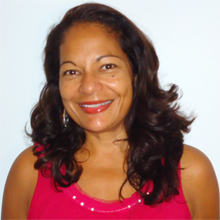 Lynn Joseph is a Trinidadian author of children's and young adult picture books set mostly in the Caribbean. Dancing in the Rain follows two Caribbean families, one in the Dominican Republic and one in New York, who find their lives intertwined following the 9/11 attacks. The book was awarded Third Prize in the 2015 Burt Award for Caribbean Literature and was named a Kirkus Best Book of 2016. Previous books include A Wave in Her Pocket, An Island Christmas, and The Color of My Words.
Lynn Joseph is a Trinidadian author of children's and young adult picture books set mostly in the Caribbean. Dancing in the Rain follows two Caribbean families, one in the Dominican Republic and one in New York, who find their lives intertwined following the 9/11 attacks. The book was awarded Third Prize in the 2015 Burt Award for Caribbean Literature and was named a Kirkus Best Book of 2016. Previous books include A Wave in Her Pocket, An Island Christmas, and The Color of My Words.
Dancing in the Rain was published in 2016, 15 years after the 9/11 events. What inspired you to write the book then?
I wasn’t inspired to write Dancing in the Rain recently. I began writing the story that became this novel many years ago, probably about three or four years after September 11, 2001, as a means of coming to terms with the horrific events and circumstances that I had witnessed firsthand. The book is semi-autobiographical as I, too, was a lawyer in New York City, who escaped back to the Caribbean in the wake of the experience. In my case I moved from New York to the U.S. Virgin Islands three months after 9/11 and because of 9/11. The Caribbean was and still is my home and I felt the urgent need to move back to my roots.
In the book’s summary, you mention Elizabeth’s vivid imagination. How does her imagination serve her and others in the face of tragedy?
Elizabeth’s imagination is both a symbol of innocence and a source of power. I believe that by allowing your imagination to develop and have a life, you can access your internal restorative power. So, imagining this story and writing it down allowed me to heal from the post traumatic stress of 9/11. An imagination is powerful when you can recreate your world, the way Elizabeth does when she cannot accept all the sadness around her. Elizabeth’s imagination also feeds her intuition, which is very powerful.
I’ve read that most of your books are inspired by your childhood in Trinidad. What elements of Dancing in the Rain are influenced by your own memories and experiences?
Dancing in the Rain was influenced by the events of my life during and after 9/11. That tragedy opened my eyes to the horrors humans are capable of firsthand. Children today are aware of terrorist incidents worldwide. This book deals with how two children and their families deal with such loss and grief stemming from atrocious acts. It’s a reminder that no matter how bleak and sinister the world may seem at times, it’s imperative to find joy in the darkness.
Dancing in the Rain takes place both in New York and the Dominican Republic. How do each of these settings influence the book’s major themes?
Setting the book in New York was necessary to establish the close ties between the characters to the 9/11 attacks on the Twin Towers. Moving the story to the beautiful island of Dominican Republic, with its tropical splendor and struggles, represents a new start for one family. For the other family, whose connection to the Twin Towers is more remote, the pain is even harder as they lost a father and husband. Distance does not make the tragedy any easier to bear.
This book shows two families’ responses to 9/11. Of all the characters, whose perspective resonated with you the most, and why?
Of all the characters in the story, I would say that the perspectives of Elizabeth and Brandt resonated equally with me. Seeing the events through their eyes, seeing their hope and struggles to overcome the loss and pain, woke me up and helped me to heal. I am a big believer in shifting your perspective if you can’t prevail in your path. A simple shift, looking at a situation in a totally different way, may be all you need. That’s what
Dancing in the Rain represents to me.
Alina O'Donnell is the editor of Literacy Daily
.